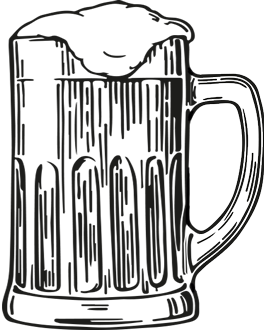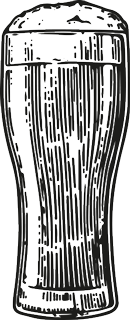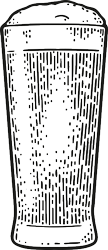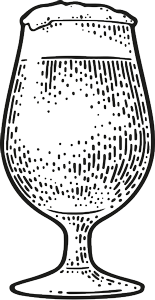Since the settlement of the colony of South Australia, beer has been at the center of our drinking culture. The eastern colonies first fell in love with rum, with convicts, military, and officials using the distilled liquor as a form of money in the early beginnings of our country. South Australia was a freely settled colony, with most settlers being from the working classes; ale and porter were the drinks of choice. In the first 10 years of the colony, all beer was imported from England, with the local brewing industry slowly taking off and by the 1880s matching the imported beverages.
In the beginning of our colony, the main way beer was enjoyed was communally at a pub or hotel, commonly after a day’s work and with only male colleagues. The local hotels were greatly influenced by English hotels, with two main glasses being available: a pint and a generically named glass.
The pint glass was named after the Imperial Pint, which was a unit of measure used in England and was 20 Imperial Fluid Ounces, or 575 milliliters in metric. To confuse things a little, the United States is one of the only countries still using historical ‘Imperial’ measurements. Their fluid ounce is different from the UK Imperial Fluid Ounce, with 1 UK Imperial Fluid Ounce equaling 28.4 ml, while 1 US Fluid Ounce is 29.57 ml. This was a simple standard glass for drinkers, with all glasses being the same size and available in all hotels. The second glass size was much more confusing. The glass was a different size in most pubs, with the only consistency being they were smaller than a pint. Some hotels would have glasses in 10 FL OZ, while others would be 15 FL OZ. This would confuse most drinkers going to a new hotel expecting a small glass and receiving three-quarters of a pint instead. Many complaints were received by newspapers on hotels serving small glasses and called for a standardized glass size. |
 |
 |
Pint 1850s
20 Imperial Fluid Ounces (575ml) |
Glass 1850s
Smaller than 20 Imperial Fluid Ounces
|
| |
|
|
|
This request came to be in the 1880s with two new standard glass sizes being introduced. The first is South Australia’s famous Butcher glass, which has a hazy history. Several hotels claimed they invented the glass size, with the Bucks Head hotel stating they had introduced them for the local butchers, while the Squatters Arms and Norfolk Arms also claimed the same thing. The reasoning was that the glass was smaller and better for the local butchers to drink during the day. These claims were made over 50 years after its introduction, and it does not make much sense. The initial Butcher glass was 15 fluid ounces (425 ml), much larger than what the butcher had evolved into by the 1930s and 1940s. The term might have come from the UK, with importers in the 1860s advertising English Butcher Glasses for sale, though there was no mention of the glass size.
The second glass size was the Long Sleever, which was usually between 16 (454 ml) to 20 fluid ounces. This glass size had originated in the Eastern states, being popular in Sydney, Melbourne, and Hobart. It would seem this glass was popular in local hotels that did not use Butcher glasses. And while most hotels used Long Sleevers in glass cups, several also served them in Pewter mugs, with a report of several young gentlemen gazing at the young ladies behind the bar, pretending to drink but using the glass bases in the Pewter Mugs as a way to disguise their glances. |
 |
 |
Butcher 1880s
15 Imperial Fluid Ounces (425ml)
|
Long Sleever 1880s
16 Imperial Fluid Ounces (454ml) |
| |
|
By the end of the nineteenth century, glass sizes had become more diverse, with several new glasses being used. The first was the Half or sometimes called the Middy, which was half a pint or 10 fluid ounces (285ml) and then the rarer Imperial Pint glass which was huge, being 40 fluid ounces (1150ml). With several reports or hotels underfilling these vessels and people only receiving 36 fluid ounces. |
 |
 |
Middy / Half 1900s
10 Imperial Fluid Ounces (285ml) |
Imperial Pint 1900s
40 Imperial Fluid Ounces (1150ml) |
| |
|
All these glass sizes were used until the start of the First World War when rationing was introduced. Barley was being used for the war effort, supplying the troops. As a result, breweries were brewing less beer, and hotels were receiving a fraction of the beer that they were used to. As a way to ration their beer, many hotels would only serve beer in glasses smaller than 12 fluid ounces. Many people would boycott these hotels, so when hotels did reintroduce the pint glasses, they were shrunk to 17 fluid ounces. This seemed to please the local drinkers, and by the end of the war, pint glasses were restored to their original 20 fluid ounce size. With the smaller pint glasses that were being used at the same size as the Butcher, the Butcher glass started taking on the smaller 12 FL OZ (340 ml) size. And for some reason, the Butcher glass didn’t return to the previous size. Many newspaper reports in the 1920s reported that many old-timers questioned what had become of the Butcher glass and how they seemed half the size of what they had become. During the war, the Long Sleever glass disappeared from hotels; it seems there were too many large glass sizes and the less popular Long Sleever was the unlucky size. |
 |
 |
Pint 194 to 1920
17 Imperial Fluid Ounces (483ml) |
Butcher 1914 to 1939
12 Imperial Fluid Ounces (340ml) |
| |
|
The depression also took its toll on glass sizes, with many hotels again using the smaller pints and Butcher glasses. There were many hotel strikes where hotels in smaller country towns would shrink the glass sizes, and the locals would picket out the front demanding they increase the glass sizes with the township of Quorn being highly publicized at the time. The 1930s would see new beer glass introduced. The first was the Schooner. The glass size had made its way into SA via Broken Hill, and filled the glass size the Long Sleever had previously, being 16 fluid ounces (454 ml). The second was the Pony, a tiny-sized glass holding less than 4 fluid ounces (115ml). |
 |
 |
Schooner 1935 to 1940
16 Imperial Fluid Ounces (454ml) |
Pony 1930s to 1953
Under 4 Imperial Fluid Ounces (Under 115ml) |
| |
|
The main influence on the odd-sized glasses in South Australia was the Second World War and the reintroduction of rationing. The drop in beer production was much worse than in the First World War, leaving hotels with little beer to sell, and some would often run out of beer. Along with the rationing, the local hotel association, the ‘United Licensed Victuallers Association’ would dictate the price and size of beers sold at hotels. As the war raged on, instead of raising beer prices, they would drop the glass size, and again this was met with much protest by local beer drinkers, but with larger issues happening, nothing came of it. |
 |
 |
Pint 1939 to 1945
18 then 17 Imperial Fluid Ounces (511ml then 483ml) |
Schooner 1939 to 1945
11 then 9 Imperial Fluid Ounces (312ml then 255ml)
|
 |
 |
Middy/Half 1939 to 1945
9 then 7 Imperial Fluid Ounces (255ml then 200ml)
|
Butcher 1939 to 1945
7 then 6 Imperial Fluid Ounces (200ml then 170ml) |
| |
|
Unlike the Eastern States, which had hotel strikes due to the smaller glass sizes, and after the war, the original glass sizes were reinstated. South Australia was not as lucky; even after the war was over, the ULVA would continue dropping the size of glasses well into the 1950s, with our glass sizes being set in 1953. The pint glass was set at 15 fluid ounces (425 ml), a Schooner was 10 fluid ounces (285 ml), a Butcher being 7 fluid ounces (200ml), and finally, the Pony set at 4 fluid ounces (115 ml). |
 |
 |
Pint 1953 to present
15 Imperial Fluid Ounces (425ml) |
Schooner 1953 to Present
10 Imperial Fluid Ounces (285ml) |
 |
 |
Butcher 1953 to Present
7 Imperial Fluid Ounces (200ml) |
Pony 1953 to Present
4 Imperial Fluid Ounces |
| |
|
This standard has stayed pretty much the same until the deregulation of the beer industry, and several new sizes were used, with the Imperial Pint glass coming back as 20 fluid ounces (575 ml), the Handle which is commonly 13 fluid ounces (370 ml), and the Fancy being the only metric glass size being 300ml. I find it very odd we still use the old Imperial measures for our beer glasses, and would be one of the only large-scale uses of these measurements we still use in Australia. |
 |
 |
Imperial Pint
20 Imperial Fluid Ounces (575ml) |
Handle
13 Imperial Fluid Ounces (370ml) |
| |
|
 |
Fancy
300ml |